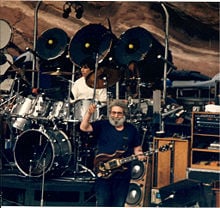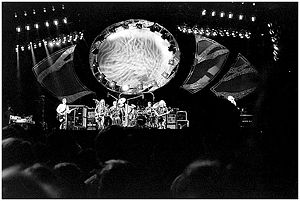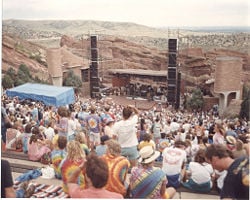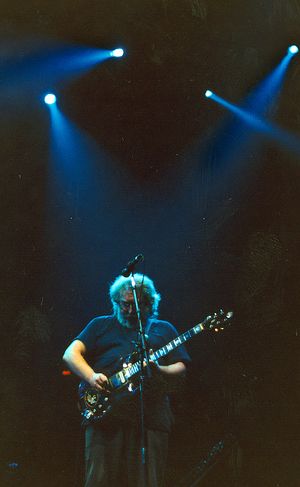Grateful Dead
| Grateful Dead | |
|---|---|
 Jerry Garcia and the Grateful Dead
| |
| Background information | |
| Also known as | The Warlocks |
| Origin | San Francisco, California, USA |
| Genre(s) | Rock |
| Years active | 1965–1995 |
| Label(s) | Warner Bros., Grateful Dead, Arista, Rhino |
| Website | www.dead.net |
| Former members | |
| Jerry Garcia Bob Weir Phil Lesh Bill Kreutzmann Ron "Pigpen" McKernan Mickey Hart Tom Constanten Keith Godchaux Donna Jean Godchaux Brent Mydland Vince Welnick | |
The Grateful Dead was an American rock band formed in 1965 in the San Francisco Bay Area.It was known for its unique and eclectic style, which fused elements of rock, folk, bluegrass, blues, reggae, country, jazz, psychedelic rock, and gospel—and for live performances of long musical improvization.
The fans of the Grateful Dead were known as "Deadheads" and were renowned for their dedication to the band's music. Some of them followed the band from concert to concert for years. As "the Dead" and its sound matured over 30 years of touring and recording, each member's stylistic contribution became more identifiable, especially guitarist Jerry Garcia, the band's de facto leader, although he never accepted the role officially.
As a highly successful, self-sustaining touring rock band, the Grateful Dead established an approach to their craft outside the standard music-industry business model. This included letting their fans record their concerts in order to advertise their music. Their emphasis on touring and creating a sense community centered on their concepts made the "Dead" the most viewed rock band in its time.
The Grateful Dead were inducted into the Rock and Roll Hall of Fame in 1994. In 2007, the group received a Grammy Lifetime Achievement Award.
History
Formation
The Grateful Dead began it career in Menlo Park, California, playing live shows at Kepler's Books. The group began as the Warlocks in early 1964 from the remnants of a Palo Alto jug band called Mother McCree's Uptown Jug Champions.
They soon moved to the Haight-Ashbury section of San Francisco, joining such groups as the Jefferson Airplane, Quicksilver Messenger Service, Big Brother & the Holding Company, and Santana in the city that was quickly becoming known as the center of the hippie counterculture of the era.
The founding members of the band were: [[guitar] and banjo player Jerry Garcia, guitarist Bob Weir, organist Ron "Pigpen" McKernan, bassist Phil Lesh, and jazz drummer Bill Kreutzmann. However, since another band was already recording under the "Warlocks" name, the group had to change its name.
The name Grateful Dead was chosen from a dictionary: "the soul of a dead person, or his angel, showing gratitude to someone who, as an act of charity, arranged their burial." The term "Grateful Dead" appears in folktales of a variety of cultures.
A new type of sound
The Grateful Dead's musical influences varied widely, including blues, rock and roll, country music, bluegrass, country-rock, and jazz. These various influences were distilled into a diverse and psychedelic whole that made the Grateful Dead "the pioneering Godfathers of the jam band world."[1]
The Grateful Dead formed during the era when bands like The Beatles and The Rolling Stones were dominating the airwaves and folk star Bob Dylan had recently released records featuring electric instrumentation. Grateful Dead members have stated that it was after attending a concert by the New York City "folk-rock" band The Lovin' Spoonful that they decided to "go electric" and look for a "dirtier" sound.
The new "Dead" music, however, was also very different from bands like Dylan's or the Spoonful, partly because band member Phil Lesh came out of a formal classical and electronic music background, while organist Ron "Pigpen" McKernan was a no-nonsense blues lover, and drummer Bill Kreutzmann had a jazz and R&B background.
Their first LP (The Grateful Dead, Warner Brothers, 1967), was released in the same year that Pink Floyd released Piper at the Gates of Dawn and the Beatles released Sgt. Pepper's Lonely Hearts Club Band.
A long, strange trip
The Grateful Dead’s early music was part of the process of defining the "psychedelic music" genre. They developed their "psychedelic" orientation out of meeting Ken Kesey in Palo Alto, California and subsequently becoming the house band to the Acid Tests he staged. After relocating to the Haight-Ashbury section of San Francisco, their "street party" music tradition developed out of the many psychedelic dances, "love-ins," open-air park events, and closed-street Haight-Ashbury block parties at which they played.
The Dead were not inclined to fit their music to an established category such as pop rock, blues, folk rock, or country/western. Individual tunes within their repertoire could be identified under one of these stylistic labels, but overall their music drew on all of these genres and more, frequently melding several of them. Often, both in performance and on recording, the Dead left room for exploratory, spacey jams.
Their early records reflected the Dead's live repertoire—lengthy instrumental jams with group improvisation, best exemplified by "Dark Star." However, lacking the energy and audience interplay of their live shows, their early albums did not sell well. The 1969 live album Live/Dead captured more of the group's essence, but commercial success did not come until Workingman's Dead and American Beauty were released in 1970. These records largely featured the band's laid-back acoustic musicianship and more traditional song structures.
As the band, and its sound, matured over 30 years of touring, playing, and recording, each member's stylistic contribution became more defined, consistent, and identifiable. Lesh, who was originally trained as a classical trumpet player with an extensive background in music theory, did not tend to play traditional blues-based bass forms, but opted for more melodic and complex lines, often sounding like a second lead guitar. Weir, too, was not a traditional rhythm guitarist, but tended to play jazz-influenced, chordal inversions at the upper end of the Dead's sound. The two drummers, Mickey Hart and Kreutzmann, developed a unique, complex interplay, balancing Kreutzmann's steady beat with Hart's interest in percussion styles outside the rock tradition. Hart often incorporated an 11-count measure to his drumming, bringing a new dimension to the band's sound that became an important part of its emerging style. Garcia's lead lines were fluid, supple, and spare, owing a great deal of their character to his training in fingerpicking and banjo.
The band's primary lyricists Robert Hunter and John Perry Barlow, wrote songs of love and loss, life and death, beauty and horror, gambling, murder, religious themes, traveling and touring. Less frequent ideas include the environment and other issues from the world of politics.
Jerry Garcia: de-facto leader
Although he intensely disliked the appellation, Jerry Garcia was the band's de-facto musical leader and the source of its identity. Garcia was a charismatic, complex figure, simultaneously writing and playing music of enormous sensitivity and insight while leading a personal life that often consisted of self-destructive excess, including well-known drug addictions, obesity, financial recklessness, and three volatile marriages. Garcia also suffered for most of his life from sleep apnea.
Touring
The Grateful Dead toured almost constantly throughout their long career, playing more than 2300 live concerts. It its early days, the band also dedicated its time and talents to their community, the Haight-Ashbury area of San Francisco, making available free food, lodging, music, and health care to all comers. With the exception of 1975, when the band was on hiatus and played only four concerts, the Grateful Dead performed many concerts every year, from their formation in April, 1965, until July 9, 1995.
Initially all their shows were in California, principally in the San Francisco Bay Area and in or near Los Angeles. They toured nationally starting in June 1967, with a few detours to Canada, Europe, and three nights at the Great Pyramid of Giza in Egypt in 1978. They appeared at the Monterey Pop Festival in 1967, and at the Woodstock Festival in 1969. Their first UK performance was at the Hollywood Music Festival in 1970. Their largest concert audience came in 1973 when they played, along with The Allman Brothers Band and The Band, before an estimated 600,000 people at the Summer Jam at Watkins Glen. Many of these concerts were preserved in the band's tape vault, and several dozen have since been released on CD and as downloads.
The Dead fostered a sense of community among fans, who became known as Deadheads, many of whom followed their tours for months or years on end.
Dissolution and continuation
Following Garcia's death in August 1995, the remaining members of the Dead formally decided to disband. The main focus of the members was to pursue various solo projects, most notably Bob Weir's Ratdog, Phil Lesh and Friends, and various projects by Mickey Hart, including music for the 1996 Olympics.
In June 1996 Bob Weir (with Ratdog) and Mickey Hart (with Mickey Hart's Mystery Box), along with Bruce Hornsby and his band, joined five other bands and toured as the Furthur Festival. In 1998's Furthur Festival, Weir, Hart, and Bruce Hornsby were joined by Phil Lesh to form a new band called The Other Ones. The Strange Remain is a live recording of The Other Ones during the 1998 Furthur Festival. The lineup of The Other Ones would shift, notably involving the addition of Bill Kreutzmann, the departure, then return, of Lesh, and the departure of Bruce Hornsby to pursue his solo work; however, the band settled on a steady lineup by 2002.
The tour of The Other Ones in 2002 began with two huge shows at celebrated Alpine Valley and continued with a late October return to Shoreline Amphitheatre and an ensuing full Autumn and Winter tour culminating in a New Years Eve show in Oakland where the band played Dark Star among other fan favorites. The members would continue to tour on and off through the end of their 2004 Summer Tour - the "Wave That Flag" tour, named after the original 1973 uptempo version of the song "U.S. Blues." The band accepted Jeff Chimenti on keyboards, Jimmy Herring on guitar, and Warren Haynes on guitar and vocals for the tour.
Members of the Dead still actively tour with their own bands—Bob Weir and Ratdog, Phil Lesh and Friends, the Mickey Hart Band, and Donna Jean and the Tricksters. Bill Kreutzmann toured the eastern U.S. in 2008 with Oteil Burbridge and Scott Murawski, and Tom Constanten often sits in with various bands.
On February 4, 2008, Mickey Hart, Phil Lesh, and Bob Weir, joined by Jackie Greene, John Molo, and Steve Molitz, performed a show entitled "Deadheads for Obama" at the Warfield in San Francisco, in support of Democratic presidential candidate Barack Obama.
Legacy
The Grateful Dead lived at the edge of the "official music industry" developing a business model that was antithetical to the idea of creating a polished album and then touring to support its sales. The model they evolved was based on touring as an end in itself, rather than as a means to promoting a studio album. Their tours included playing multi-night runs at large arenas and stadiums from year to year. Their shows, usually longer than two hours, and sometimes much longer, rarely featured the same song twice in succeeding nights and never played the songs in exactly the same way.
These unique qualities made the Grateful Dead the most viewed rock band in its time. It spawned a faithful following of Deadheads that came from all parts of society, many of whom went on to become influential artists themselves. The band also condoned the live taping of its shows which spread the Dead's music "virally" long before the idea of viral marketing was formally conceived. The Dead thus proved that a touring rock band could be successful and self-sustaining outside of the standard music-industry business model.
In 2004, Rolling Stone ranked the Grateful Dead number 55 on its list of the 100 Greatest Artists of All Time. On February 10, 2007, the Dead received a Grammy Lifetime Achievement Award. The award was accepted on behalf of the band by Mickey Hart and Bill Kreutzmann.
Discography
Main studio and contemporary live recordings
- The Grateful Dead, 1967
- Anthem Of The Sun, 1968
- Aoxomoxoa, 1969
- Live/Dead, 1969
- Workingman's Dead, 1970
- American Beauty, 1970
- Grateful Dead (Skull & Roses), 1971
- Europe '72, 1972
- History Of The Grateful Dead, Vol. 1 (Bear's Choice), 1973
- Wake Of The Flood, 1973
- Grateful Dead From The Mars Hotel, 1974
- Blues For Allah, 1975
- Steal Your Face, 1976
- Terrapin Station, 1977
- Shakedown Street, 1978
- Go To Heaven, 1980
- Reckoning, 1981
- Dead Set, 1981
- In The Dark, 1987
- Dylan And The Dead (with Bob Dylan), 1988
- Built To Last, 1989
- Without A Net, 1990
- Infrared Roses, 1991
- So Many Roads (1965-1995), 1999
- The Golden Road (1965-1973), 2001
- Postcards Of The Hanging, 2002
- Birth Of The Dead, 2003
- Beyond Description, 2004
- Rare Cuts and Oddities 1966, 2005
Singles
- "Stealin' / Don't Ease Me In," 1966
- "The Golden Road (To Unlimited Devotion) / Cream Puff War," 1967
- "Dark Star / Born Cross-Eyed," 1968
- "Dupree's Diamond Blues / Cosmic Charlie," 1969
- "Uncle John's Band / New Speedway Boogie," 1970
- "Truckin' / Ripple," 1971
- "Johnny B. Goode / So Fine," (with Elvin Bishop Group), 1972
- "Johnny B. Goode / Truckin," 1972
- "Sugar Magnolia / Mr. Charlie," 1972
- "Let Me Sing Your Blues Away / Here Comes Sunshine," 1973
- "Eyes Of The World / Weather Report Suite Part 1," 1973
- "Truckin' / Sugar Magnolia," 1974?
- "U. S. Blues / Loose Lucy," 1974
- "The Music Never Stopped / Help On The Way," 1975
- "Franklin's Tower / Help On The Way," 1976
- "Dancing In The Streets / Terrapin Station," 1977
- "Passenger / Terrapin Station," 1977
- "Good Lovin' / Stagger Lee," 1978
- "Shakedown Street / France," 1979
- "Alabama Getaway / Far From Me," 1980
- "Don't Ease me In / Far From Me," 1980
- "Alabama Getaway / Shakedown Street," 1981
- "Touch Of Grey / My Brother Esau," 1987
- "Throwing Stones / When Push Comes To Shove," 1988
- "Alabama Getaway / Shakedown Street / Throwing Stones," 1988
- "Touch Of Grey / Throwing Stones," 1988
- "Foolish Heart / We Can Run," 1989
Notes
- ↑ Garofalo, pg. 219
ReferencesISBN links support NWE through referral fees
- Blakesberg, Jay, and Jackson, Blair. Between the Dark and Light: The Grateful Dead. San Francisco: Backbeat Books, 2002. ISBN 978-0879307233
- Dodd, David G., and Spaulding, Diana. The Grateful Dead Reader. New York: Oxford University Press, 2000. ISBN 978-0195124705
- Gans, David, and Simon, Peter. Playing in the Band: An Oral and Visual Portrait of the Grateful Dead. New York: St. Martin's Press, 1985. ISBN 978-0312616304
External links
Credits
New World Encyclopedia writers and editors rewrote and completed the Wikipedia article in accordance with New World Encyclopedia standards. This article abides by terms of the Creative Commons CC-by-sa 3.0 License (CC-by-sa), which may be used and disseminated with proper attribution. Credit is due under the terms of this license that can reference both the New World Encyclopedia contributors and the selfless volunteer contributors of the Wikimedia Foundation. To cite this article click here for a list of acceptable citing formats.The history of earlier contributions by wikipedians is accessible to researchers here:
The history of this article since it was imported to New World Encyclopedia:
Note: Some restrictions may apply to use of individual images which are separately licensed.


